| Chuck Wagon from Wikipedia
A chuckwagon or chuck wagon is a
type of wagon historically used to carry food and cooking equipment on
the prairies of the United States and Canada. Such wagons would form part
of a wagon train of settlers or feed traveling workers such as cowboys
or loggers.
In modern times, chuckwagons feature
in certain cooking competitions and events. Chuckwagons are also used in
a type of horse racing known as chuckwagon racing.
| History
While some form of mobile kitchens had existed for generations,
the invention of the chuckwagon is attributed to Charles Goodnight, a Texas
rancher who introduced the concept in 1866. Goodnight modified the Studebaker
wagon, a durable army-surplus wagon, to suit the needs of cowboys driving
cattle from Texas to sell in New Mexico. He added a "chuck box" to the
back of the wagon with drawers and shelves for storage space and a hinged
lid to provide a flat cooking surface. A water barrel was also attached
to the wagon and canvas was hung underneath to carry firewood. A wagon
box was used to store cooking supplies and cowboys' personal items.
Chuckwagon food typically included easy-to-preserve items
like beans and salted meats, coffee, and sourdough biscuits. Food would
also be gathered en route. On cattle drives, it was common for the "cookie"
who ran the wagon to be second in authority only to the "trailboss". The
cookie would often act as cook, barber, dentist, and banker.
The term "chuck wagon" comes from "chuck", a slang term
for food, and not from the nickname for "Charles".
|
.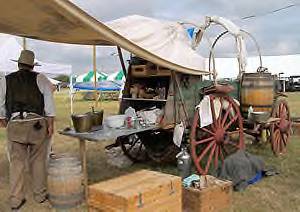
A historical recreation of a chuckwagon at the
Texas Parks and Wildlife Expo in Austin |
| Cook-offs
The American Chuckwagon Association is an organization
dedicated to the preservation of the heritage of the chuckwagon. Its members
participate in chuckwagon cook-offs throughout much of the US. Through
these events, the members educate the public on the history and traditions
surrounding the chuckwagon.
At a chuckwagon cook off, each wagon is judged on the
authenticity of the wagon. Wagons must be in sound drivable condition,
with equipment and construction available in the late 1800s. Contents of
the chuck-box, including utensils, must also match what would have been
used during the era. Wagons are also judged on the attire of their cooks.
A typical chuckwagon cookoff is composed of 5 food categories: Meat (usually
chicken-fried steak), Beans (pinto), Bread (sourdough or yeast), Dessert
(usually peach cobbler), and potatoes. A team of judges evaluates the entries
from each wagon, giving each a score. Once scores are tabulated, prizes
are awarded to the top wagons. |
.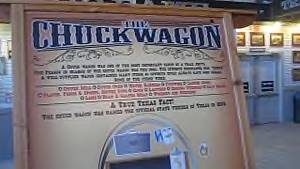
Charles Goodnight's chuckwagon was named in 2003
as the "official state vehicle" of Texas; this exhibit
is at the Texas Cowboy Hall of Fame
in the Fort Worth Stockyards in Fort Worth. |
One of the most famous chuckwagon cook-offs is the Lincoln
County Cowboy Symposium. Held annually for some two decades, this event
attracts thousands to Ruidoso, New Mexico.
Among the few chuckwagon cook-offs east of the Mississippi
River takes place during SaddleUp! each February in Pigeon Forge, Tennessee.
Held just outside Great Smoky Mountains National Park, SaddleUp! also features
a cowboy symphony and cowboy church services over a four-day period.
The Academy of Western Artists presents an annual award
for outstanding chuckwagon cooking as well as honors in other fields relating
to the culture of the American cowboy.
| Racing
Chuckwagon racing is an event at some rodeos mainly in
Western Canada such as the Calgary Stampede. Chuckwagon races were held
from 1952 until 1998 at Cheyenne Frontier Days, one of America's biggest
rodeos. There are a few professional chuckwagon racing circuits that operate
in North America with the premiere circuit being run by the World Professional
Chuckwagon Association (WPCA) based in Calgary, Alberta, the Western Chuckwagon
Association out of Grande Prairie, AB, and Canadian Professional Chuckwagon
Association out of |
.
The Rangeland Derby at the Calgary Stampede 2006
. |
Saskatchewan. A yearly chuckwagon race event is still held
in Clinton, Arkansas.Chuckwagons are raced around a figure eight barrel
obstacle, and the stove and tent poles within the wagon must not be lost.
The racing team also has from two to four "outriders" who load the stove
and tent poles at the start and must finish the race with the chuckwagon.
Many such races are held each year in Western Canadian cities and towns.
Animal welfare
Chuckwagon racing is highlighted by animal welfare experts
as dangerous to the horses, due to the unusually high risk of broken limbs
and other bones. Horses die frequently as a result and animal welfare charities
are trying to raise awareness about the sport in this light. In July 2011,
a horse died in the chuckwagon race on the opening night of the Calgary
Stampede.
Chuckwagon suppers
Tourists, mostly in the summers, can experience chuckwagon
suppers followed by live entertainment by such groups as the Flying J Wranglers
at the Flying J Ranch in Alto near the resort city of Ruidoso, New Mexico.
Two such suppers are available in Colorado: in Durango, and Colorado Springs
at the Flying W Ranch. Other suppers are available in Jackson, Wyoming,
the Black Hills at Rapid City, South Dakota, and in Branson, Missouri.
|
| Fort Hays from Wikipedia
Fort Hays was an important frontier outpost of the United
States Army located in Hays, Kansas between 1865 and 1889. Fort Hays was
the home of several well-known Indian wars regiments including the Seventh
U.S. Cavalry, the Fifth U.S. Infantry, and the Tenth U.S. Cavalry, whose
black troopers were better known as buffalo soldiers. The fort was originally
located about five miles south of present day Walker, Kansas.
History
At first called Fort Fletcher (after Governor Thomas C.
Fletcher of Missouri), it became operational on October 11, 1865. The army
garrisoned the fort with the "Galvanized Yankees" of Companies F and G,
1st U.S. Volunteer Infantry under the command of Lt. Col. William Tamblyn,
supplemented by detachments of the 13th Missouri Cavalry, to protect the
stage and freight wagons of the Butterfield Overland Despatch traveling
along the Smoky Hill Trail to Denver. Two additional companies of Tamblyn's
command and small detachments of the 13th Missouri Cavalry were stationed
along the line farther west, Company A at Monument Station 100 miles from
Fort Fletcher, and Company I at Pond's Creek Station, 50 miles beyond that.
Fort Fletcher's troops spent much of their time away from
their post, guarding stage stations and escorting travelers. Fort Fletcher
was closed in May 1866. There are several reasons why it was closed. The
army was shorthanded, needed funds to maintain the post were unavailable,
and Indians temporarily had forced the stageline from the route. This abandonment
was not permanent, however, and Fort Fletcher was reestablished in October.
Soon after its reoccupation the fort's name was changed. The Fort received
the name "Fort Hays" from Civil War general Alexander Hays, who had been
killed in 1864 at the Battle of the Wilderness.
New Location
The troops at Fort Hays continued to aid the railroad
crews, but the post's location proved to be unsatisfactory for two reasons:
the railroad was following a route to the north of the old trail and the
post was located in a floodplain that could be destructive. General Winfield
Scott Hancock, made the decision to move the post nearer the railroad while
visiting there in early 1867. He determined that the post could better
serve the railroad if it were moved to a site near where the railroad crossed
Big Creek. The new and final location of Fort Hays would be located just
south of present day Hays, Kansas. The new Fort Hays site was officially
occupied on June 23, 1867.
The new fort, like other Plains forts, was not a true
fortification but appeared to be more like a frontier settlement. There
was no wall around the post, and the only defensive structure was a blockhouse.
The post was designed as a base for supplies and troops who could be dispatched
into the field to protect vulnerable people and places when Indian resistance
appeared.
Abandonment
Fort Hays was abandoned on November 8, 1889. A decade
later, Congress transferred the original land to the State of Kansas to
be used for a branch of the state agricultural college. Fort Hays State
University, the only state university in the western half of Kansas, evolved
from this.
Fort Hays State Historic Site
The Kansas Historical Society maintains several buildings
as a museum known as the Fort Hays State Historic Site. Four of the original
buildings can be visited: the 1867 stone blockhouse, 1872 stone guardhouse,
and two of the frame officers' quarters, which have been outfitted with
period furnishings. Also on exhibit are Native American artifacts.
Trivia
In 1868 General Philip Sheridan reported
seeing a herd of 300,000 buffalo near Fort Hays. He estimated the herd
covered a territory
90 miles in length and 25 miles wide.
Fort Hays has been featured in three
movies: Dances with Wolves starring Kevin Costner, the 1997 CBS-TV movie
Stolen Women,
Captured Hearts starring Janine Turner
and Michael Greyeyes, and the 1937 movie The Plainsman starring Gary Cooper.
Fort Hays is also featured in the
17-week ABC military-western series Custer, which aired during the fall
of 1967. It starred Wayne
Maunder in the title role.
Blue Light Lady
There is an often reported paranormal sighting known around
Fort Hays. Known commonly as the 'Blue Light Lady,' the ghost is allegedly
the spirit of Elizabeth Polly, who was a nurse during the time Fort Hays
was an operational military fort. The sightings of a blue light center
around Sentinel Hill, which was a supposed favorite spot of Polly's, who
asked to be buried on top of it. Sentinel Hill has a burial marker on top
of it, but reports are mixed as to whether or not she is actually buried
there. Some contend that the grave found at the base of the hill was not
Polly, but rather a Mexican cattleman, due to the marker's Spanish inscription.
In fact the "Lonely Grave," as it is called, may not be an actual burial
site at all as no remains were found in attempts to fulfill Miss Polly's
wishes by moving her to the top of the hill. This is also refuted because
the actual Sentinel Hill is completely made of bedrock, therefore making
it a highly unlikely burial ground.
Notable and Temporary Residents
Wild Bill Hickok
Buffalo Bill Cody
General Nelson Miles
General Philip Sheridan
Lieutenant Colonel George Armstrong
Custer
General, then Captain Louis H. Carpenter,
Medal of Honor winner for 1868 action, Civil War, Indian Wars and Spanish-American
War.
Some times Commander of Fort Hays.
|
| History of Arizona from Wikipedia
The history of Arizona as recorded by Europeans began
in 1539 with the first documented exploration of the area by Marcos de
Niza, early work expanded the following year when Francisco Vásquez
de Coronado entered the area as well. Arizona was part of Mexico from 1822,
but the settled population was small. In 1848, the United States took possession
of most of it after the Mexican-American War. The Gadsden Purchase secured
the Tucson area in 1853. In 1863, Arizona was split off from the Territory
of New Mexico into its own entity. The remoteness was eased by the arrival
of railroads in 1880. Arizona became a state in 1912, but was primarily
rural with an economy based on cattle, cotton, citrus and copper. Dramatic
growth came after 1945, as retirees especially appreciated the warm weather
and low costs. Major issues in recent years include ethnic hostility between
Anglos and Hispanics, and the bust that followed the real estate bubble
of the 2000s.
Mexican Arizona
Arizona was thinly settled by Mexico in the 1840s, with
little protection from Indian raids. The U.S. won the Mexican-American
War (18461848) and in the Treaty of Guadalupe Hidalgo (1848), Mexico ceded
to the U.S. the northern 70% of modern-day Arizona.
|
.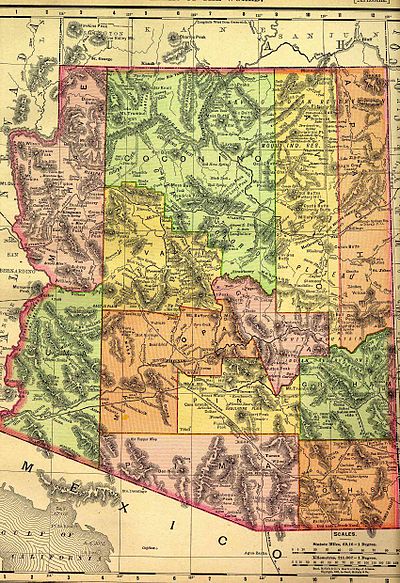
1895 map (Rand McNally) Double click to enlarge |
| American Arizona
Starting in 1853, the entirety of present-day Arizona
was part of the New Mexico Territory. In 1849, the California Gold Rush
led as many as 50,000 miners to travel across the region, leading to a
booms in Arizona's population. In 1850, Arizona and New Mexico formed the
New Mexico Territory. In 1853, President Franklin Pierce sent James Gadsden
to Mexico City to negotiate with Santa Anna, and the United States bought
the remaining southern strip area of Arizona and New Mexico in the Gadsden
Purchase.
Before 1846 the Apache raiders expelled most Mexican ranchers.
One result was that large herds of wild cattle roamed southeastern Arizona,
By 1850, the herds were gone, killed by Apaches, American sportsmen, contract
hunting for the towns of Fronteras and Santa Cruz, and roundups to sell
to hungry Mexican War soldiers. and forty-niners en route to California.
Civil War
During the Civil War, on March 16, 1861, citizens in southern
New Mexico Territory around Mesilla (now in New Mexico) and Tucson invited
take-over by the Confederacy. They especially wanted restoration of mail
service. These secessionists hoped that a Confederate Territory of Arizona
(CSA) would take control, but in March 1862, Union troops from California
captured the Confederate Territory of Arizona and returned it to the New
Mexico Territory.
The Battle of Picacho Pass, April 15, 1862, was a battle
of the Civil War fought in the CSA and one of many battles to occur in
Arizona during the war. Between three sides, Apaches, Confederates and
Union forces. In 1863, the U.S. split up New Mexico along a north-south
line to create the Arizona Territory. Prescott was a small village when
it was replaced Tucson as the territorial capital in 1877.
Indian control
In the late 19th century the Army built a series of forts
to guarantee the Indians would stay on their reservations. The first was
Fort Defiance, set up 1851 to awe the Navajos. Small skirmishes were common.
In April 1860 one thousand Navajo warriors under Manuelito attacked the
fort and were beaten off. The fort was temporarily abandoned during the
Civil War but was reoccupied in 1864 by Colonel Kit Carson and the 1st
New Mexico Infantry. Carson's force trapped the Navajos and forced them
on the Long Walk to the reservation. They promised to no longer raid their
neighbors, and instead focused on sheep ranching; the more sheep a man
owned the higher his social status. Fort Defiance was the agency for the
new Navajo reservation until 1936; today it provide medical services to
the region.
Fort Apache was built on the Fort Apache Indian Reservation
by soldiers from the 1st Cavalry and 21st Infantry in 1870. Only one small
battle took place, in September 1881, with three soldiers wounded. When
the reservation Indians were granted U.S. citizenship in 1924, the fort
was permanently closed down. Fort Huachuca, east of Tucson, was founded
in 1877 as the base for operations against Apaches and raiders from Mexico.
From 1913-33 the fort was the base for the "Buffalo Soldiers" (black soldiers)
of the 10th Cavalry Regiment. During World War II, the fort expanded to
25,000 soldiers, mostly in segregated all-black units. Today the fort remains
in operation and houses the U.S. Army Intelligence Center and the U.S.
Army Network.
Ranching
After the Civil War Texans brought large-scale ranching
to southern Arizona. They introduced their proven range methods to the
new grass country. Texas rustlers also came, and brought lawlessness. Inexperienced
ranchers brought poor management resulted in overstocking, and introduced
destructive diseases. Local cattleman organizations were formed to handle
these problems. The Territory experienced a cattle boom in 1873-91, as
the herds were expanded from 40,000 to 1.5 million head. However the drought
of 1891-93 killed off over half the cattle and produced severe overgrazing.
Efforts to restore the rangeland between 1905 and 1934 had limited success,
but ranching continued on a smaller scale. Arizona's last major drought
came in the Dust Bowl years of 1933-34. This time Washington |
..
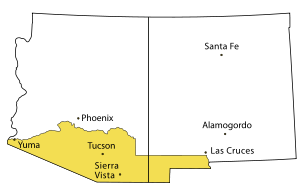
The Gadsden Purchase
(shown with present-day state boundaries and cities)
.
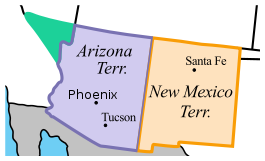
Arizona Territory in 1866
.
..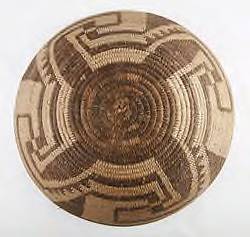
This ornate grain basket by Akimel
O'odham dates
from the early 20th century, showing
the
Native American dimension to the
state's culture.
.
.
.
.
.
.
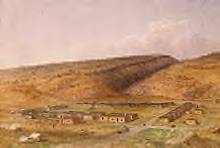
Fort Defiance, painted 1873 by Seth Eastman |
stepped in as the Agricultural Adjustment Administration
spent $100 million to buy up the starving cattle. The Taylor Grazing Act
placed federal and state agencies in control of livestock numbers on public
lands. Most of the land in Arizona is owned by the federal government,
which leased grazing land to ranchers at low cost. Ranchers invested heavily
in blooded stock and equipment. Wilson argues that after 1950 higher fees
and restrictions in the name of land conservation caused a sizable reduction
in available grazing land. The ranchers had installed three-fifths of the
fences, dikes, diversion dams, cattleguards, and other improvements, but
the new rules reduced the value of that investment. In the end, Wilson
argues, sportsmen and environmentalists maintained a political advantage
by denouncing the ranchers as land-grabbers, political corrupters, and
preyers on the publicly owned natural resources.
| Copper
In 1880 Lewis Williams opened a copper smelter in Bisbee
and the copper boom began, as the nation turned to copper wires for electricity.
The arrival of railroads in the 1880s made mining even more profitable,
and national corporations bought control of the mines and invested in new
equipment. Mining operations flourished in numerous boom towns, such as
Bisbee, Douglas, Ajo and Miami.
Wild West
Arizona's "wild west" reputation was well deserved. Tombstone
was a notorious mining town that flourished longer than most, from 1877
to 1929. Silver was discovered in 1877, and by 1881 the town had a population
of over 10,000. Western story tellers and Hollywood film makers made as
much money in Tombstone as anyone, thanks to the arrival of Wyatt Earp
and his brothers in 1879. |
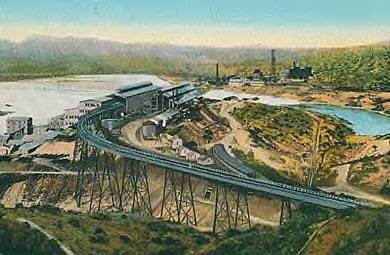
Inspiration Copper Company smelter at Miami, Arizona,
c. 1915 |
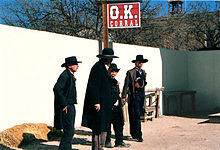 .. ..
Hourly re-enactment for tourists of the
Gunfight at the O.K. Corral |
They bought shares in the Vizina mine, water rights,
and gambling concessions, but Virgil, Morgan and Wyatt were soon appointed
as federal and local marshals. They killed three outlaws in the Gunfight
at the O.K. Corral, the most famous gunfight of the Old West. In the aftermath,
Virgil Earp was maimed in an ambush and Morgan Earp was assassinated while
playing billiards. Walter Noble Burns's novel Tombstone (1927) made Earp
famous. Hollywood celebrated Earp's Tombstone days with John Ford's My
Darling Clementine (1946), John Sturges's Gunfight at the O.K. Corral (1957)
and Hour of the Gun (1967), Frank Perry's Doc (1971), George Cosmatos's
Tombstone (1993), and Lawrence Kasdan's Wyatt Earp (1994). They solidified
Earp's modern reputation as the Old West's deadliest gunman.
Jennie Bauters (18621905), was a madam who operated brothels
in the Territory in 1896-1905. She was an astute businesswoman with an
eye for real estate appreciation, and a way with the town fathers of Jerome
regarding taxes and restrictive ordinances. She was not always sitting
pretty; |
| her brothels were burned in a series of major fires that
swept the business district; her girls were often drug addicts. As respectability
closed in on her, in 1903 she relocated to the mining camp of Acme. In
1905, she was murdered by a man who had posed as her husband.
Jennie Bauters (18621905), was a madam who operated brothels
in the Territory in 1896-1905. She was an astute businesswoman with an
eye for real estate appreciation, and a way with the town fathers of Jerome
regarding taxes and restrictive ordinances. She was not always sitting
pretty; her brothels were burned in a series of major fires that swept
the business district; her girls were often drug addicts. As respectability
closed in on her, in 1903 she relocated to the mining camp of Acme. In
1905, she was murdered by a man who had posed as her husband.
20th century
Tourism |
.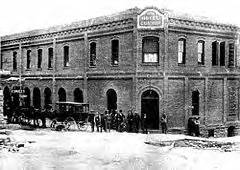
Connor Hotel in Jerome |
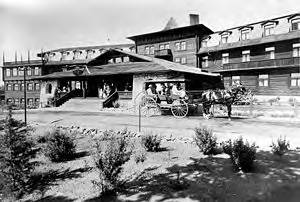 . .
The luxury Harvey House hotel opened in 1905
overlooking the South Rim of the Grand Canyon;
it remains in operation as the El Tovar Hotel. |
By 1869 Americans were reading John Wesley Powell's reports
of his explorations of the Colorado River. In 1901, the Santa Fe Railroad
reached Grand Canyon's South Rim. With railroad, restaurant and hotel entrepreneur
Fred Harvey leading the way, large-scale tourism began that has never abated.
The Grand Canyon has become an iconic symbol of the West and the nation
as a whole.
Chinese
The Chinese came to Arizona with the construction of the
Southern Pacific Railroad in 1880. Tucson was the main railroad center
and soon had a Chinatown with laundries for the general population and
a rich mix of restaurants, groceries and services for the residents. Chinese
and Mexican merchants and farmers transcended racial differences to form
'guanxi,' which were relations of friendship and trust. Chinese leased
land from Mexicans, operated grocery stores, and aided compatriots attempting
to enter the United States from Mexico after the Mexican Revolution in
1910. Chinese merchants helped supply General John Pershing's army in its
expedition against Pancho Villa. Successful Chinese in Tucson led a viable
community based on social integration, friendship, and kinship. |
.
| Statehood
In the early 20th century, Arizona almost entered the
Union as part of New Mexico in a Republican plan to keep control of the
U.S. Senate. The plan, while accepted by most in New Mexico, was rejected
by most Arizonans. Progressives in Arizona favored inclusion in the state
constitution of initiative, referendum, recall, direct election of senators,
woman suffrage, and other reforms. Most of these proposals were included
in the constitution that was submitted to Congress in 1912. President William
Howard Taft insisted on removing the recall provision (because it would
allow recall of judges) before he would approve it. It was removed, Taft
signed the statehood bill on February 14, 1912, and state residents promptly
put the provision back in. Hispanics had little voice or power. Only one
of the 53 delegates at the constitutional convention was Hispanic, and
he refused to sign. In 1912 women gained suffrage (the vote) in the state,
eight years before the country as a whole. |
.
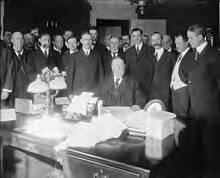
Signing of Arizona statehood bill |
Arizona's first Congressman was Carl Hayden (18771972).
He was the son of a Yankee merchant who came to Tempe because he needed
dry heat for his bad lungs. Carl attended Stanford University and moved
up the political ladder as town councilman, county treasurer and Maricopa
County sheriff, where he nabbed Arizona's last train robbers. He also started
building a coalition to develop the state's water resources, a lifelong
interest. A liberal Democrat his entire career, Hayden was elected to Congress
in 1912 and moved to the Senate in 1926. Reelection followed every six
years as he advanced toward the chairmanship of the powerful Appropriations
Committee, which he finally reached in 1955. His only difficult campaign
came in 1962, at age 85, when he defeated a young conservative. He retired
in 1968 after a record 56 years in Congress. His great achievement was
his 41-year battle to enact the Central Arizona Project that would provide
water for future growth.
The Great Depression
The Great Depression of 1929-39 hit Arizona hard. At first
local, state and private relief efforts focused on charity, especially
by the Community Chest and Organized Charities programs. Federal money
started arriving with the Federal Emergency Relief Committee in 1930. Different
agencies promoted aid to the unemployed, tuberculosis patients, transients,
and illegal immigrants. The money ran out by 1931 or 1932, and conditions
were bad until New Deal relief operations began on a large scale in 1933.
Construction programs were important, especially Hoover Dam (originally
called Boulder Dam)), begun by President Herbert Hoover. It is a concrete
arch-gravity dam in the Black Canyon of the Colorado River, on the border
with Nevada. It was constructed by the Federal Bureau of Reclamation between
1931 and 1936. It operationalized a schedule of water use set by the Colorado
River Compact of 1922 that gave Arizona 19% of the river's water, with
25% to Nevada and the rest to California.
World War II
During World War II (194145) Mexican-American community
organizations were very active in patriotic efforts to support American
troops abroad, and made efforts to support the war effort materially and
to provide moral support for the young American men fighting the war, especially
the young Mexican-American men from local communities. Some of the community
projects were cooperative ventures in which members of both the Mexican-American
and Anglo communities participated. Most efforts made in the Mexican-American
community, however, represented localized American home front activities
that were separate from the activities of the Anglo community.
Mexican-American women organized to assist their servicemen
and the war effort. An underlying goal of the Spanish-American Mothers
and Wives Association was the reinforcement of the woman's role in Spanish-Mexican
culture. The organization raised thousands of dollars, wrote letters, and
joined in numerous celebrations of their culture and their support for
Mexican-American servicemen. Membership reached over 300 during the war
and eventually ended its existence in 1976.
Heavy government spending during World War II revitalized
the Arizona economy, which was still based on copper mining, citrus and
cotton crops and cattle ranching, with a growing tourist business.
Military installations peppered the state, such as Davis-Monthan
Field in Tucson, a main training center for air force bomber pilots. Two
relocation camps opened for Japanese and Japanese Americans brought in
from the West Coast.
| After 1945
The population grew rapidly after 1945, exploding by almost
ten times from 700,000 in 1950 to over 5 million in 2000. Most of the growth
was in the Phoenix area, with Tucson a distant second. Urban growth doomed
the state's citrus industry, as the groves were turned into housing developments.
The cost of water made cotton growing less and less profitable, so the
state's production steadily declined. By contrast, manufacturing employment
jumped from 49,000 in 1960 to 183,000 by 1985, with half the workers in
well-paid high tech firms such as Motorola, Hughes Aircraft, and Goodyear
Aircraft, Honeywell, and IBM in the Phoenix area. By 1959, Hughes Aircraft
built advanced missiles with five thousand workers in Tucson.
National leadership
Although a small state, Arizona produced numerous national
leaders for both parties. Two Republican Senators were presidential nominees:
Barry Goldwater in 1964 and John McCain in 2008. Both carried Arizona and
lost the national election. Senator Ernest McFarland, a Democrat, was the
Majority Leader of the U.S. Senate 1951-52, and Congressman John Rhodes
was the Republican Minority Leader in the House, 1973-81. Democrats Bruce
Babbitt (Governor 1978-87) and Morris Udall (Congressman 1961-90) were
contenders for their party's presidential nomination. In 1981 Sandra Day
O'Connor became the first woman on the Supreme Court, serving until 2006.
Retirement communities
The warm winters and low cost of living attracted retirees
from the snow belt who moved permanently to Arizona after 1945, bringing
their pensions, Social Security and savings with them. Trolander shows
that real estate entrepreneurs catered to them with new communities with
amenities pitched to older |
Historical populations
Census Pop. %±
1860 6,482
1870 9,658
49.0%
1880 40,440 318.7%
1890 88,243 118.2%
1900 122,931 39.3%
1910 204,354 66.2%
1920 334,162 63.5%
1930 435,573 30.3%
1940 499,261 14.6%
1950 749,587 50.1%
1960 1,302,161 73.7%
1970 1,745,944 34.1%
1980 2,718,215 55.7%
1990 3,665,228 34.8%
2000 5,130,632 40.0%
2010 6,392,017 24.6%
Sources: 1910-2010 |
people, and with few facilities for children. Typically they
are "gated" (with controlled access), and have pools, recreation centers,
and sometimes a golf course. In 1954, two developers bought 320 acres (1.3
km2) of farmland near Phoenix and opened the nation's first master-planned,
adult community dedicated exclusively to retirees at Youngtown. In 1960,
developer Del Webb, inspired by the amenities in trailer parks in Florida,
added facilities for "active adults" in his new Sun City planned community
near Phoenix. In 1962 Ross Cortese opened the first of his gated Leisure
Worlds. Other developers copied the popular model so that by 2000, 18%
of the retirees in the state lived in "lifestyle" communities.
Environmental issues
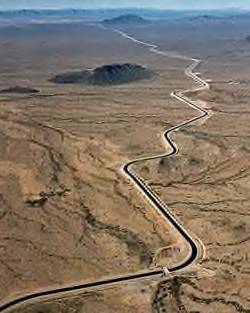 . .
Water delivered by the
Central Arizona Project's canal. |
The issues of the fragile natural environment, compounded
by questions of water shortage and distribution, led to numerous debates.
The debate crossed traditional lines, so that the leading conservative,
Senator Barry Goldwater, was also keenly concerned. For example, Goldwater
supported the controversial Colorado River Storage Project (CRSP). He wrote:
"I feel very definitely that the [Nixon] administration
is absolutely correct in cracking down on companies and corporations and
municipalities that continue to pollute the nations air and water. While
I am a great believer in the free competitive enterprise system and all
that it entails, I am an even stronger believer in the right of our people
to live in a clean and pollution-free environment. To this end, it is my
belief that when pollution is found, it should be halted at the source,
even if this requires stringent government action against important segments
of our national economy."
Water issues were central. Agriculture consumed 89% of
the state's strictly limited water supply, while generating only 3% of
the state's income. The Groundwater Management Act of 1980, sponsored by
Governor Babbitt, raised the price of water to farmers, while cities had
to reach a "safe yield" so that the groundwater usage did not exceed natural
replenishment. New housing developments had to prove they had enough water
for the next hundred years. Desert foliage suitable for a dry region soon
replaced water-guzzling grass in Arizona lawns.
Cotton acreage declined dramatically, freeing up land
for suburban sprawl as well as releasing large amounts of water and ending
the need for expensive specialized machinery. Cotton acreage plunged from
120,000 acres in 1997 to only 40,000 acres in 2005, even as the |
federal treasury gave the state's farmers over $678 million
in cotton subsidies. Many farmers collect the subsidies but no longer grow
cotton. About 80% of the state's cotton is exported to textile factories
in China and (since the passage of NAFTA) to Mexico.
|
.
All articles submitted to the "Brimstone
Gazette" are the property of the author, used with their expressed permission.
The Brimstone Pistoleros are not
responsible for any accidents which may occur from use of loading
data, firearms information, or recommendations published on the Brimstone
Pistoleros web site. |
|